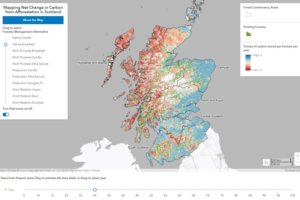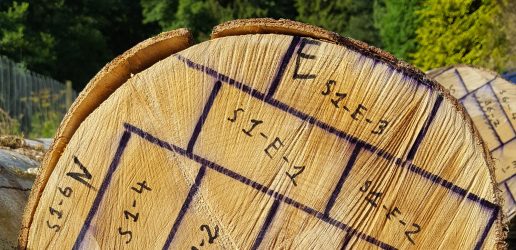Tree planting and woodland expansion are often touted as desirable ways to soak up atmospheric carbon and help stem climate change. They are a frequent feature of climate change mitigation policies, but these policies often assume that all new trees are good for carbon storage, which isn’t necessarily true in all circumstances.
Researchers at the James Hutton Institute, Forest Research and the University of Aberdeen have developed a new way to quantify the potential carbon storage for eleven different forestry management alternatives in Scottish locations using a novel spatial analysis method. The new method was then used to develop an online mapping tool that clearly represents, visually, the net changes in carbon from afforestation over time for different woodland planting options.

The maps produced using this new method combine above- and below-ground carbon, highlighting where net carbon gains and losses are likely to occur, how long they persist after afforestation and how they vary with pre-existing land use, soil types, weather conditions and afforestation management strategies.
Dr Keith Matthews, co-author of the study, said: “Using area-based carbon storage targets means there is uncertainty over the quantity and timing of the carbon storage that new afforestation delivers. Having an explicit carbon tonnage target for new forestry as a whole, would ensure that the amount of carbon storage assumed within Scotland’s Climate Change Plan is transparent, achievable and delivered while still allowing flexibility to balance the trade-offs between carbon storage and the many other objectives and benefits that new woodlands are expected to deliver.”
“Establishing lower-yielding trees extensively on low-quality ground with the organo-mineral soils that underlie more than half of Scotland’s afforested area will in most cases result in net emissions that persist for decades”, added co-author Prof Pete Smith, of the University of Aberdeen.
Dr Mike Perks, Senior Climate Scientist at Forest Research and fellow co-author of the study, said: “Using more productive classes of land for afforestation can deliver more net carbon sequestration per hectare and could mean greater carbon storage than foreseen in emission reduction plans.
“This work shows why it is important to continue with the existing presumption against planting trees in deep peat areas, but that additional incentives or constraints may be needed to achieve the overall rates of emission mitigation that policy commitments imply”, Dr Matthews added.
The work was funded by the Rural & Environment Science & Analytical Services Division of the Scottish Government as part of the 2016-2021 Strategic Research Programme.
Recently published Scottish research by the James Hutton Institute and other partners also shows that if trees are planted in inappropriate locations – such as peat bogs and heather moorland – more carbon can be released than absorbed, at least in the first decades after planting.
Paper: Matthews, K.B., Wardell-Johnson, D., Miller, D.G., Fitton, N., Jones, E., Bathgate, S., Randle, T., Matthews, R., Smith, P., Perks, M. (2020) Not seeing the carbon for the trees? Why area-based targets for establishing new woodlands can limit or underplay their climate change mitigation benefits. Land Use Policy, Volume 97. https://doi.org/10.1016/j.landusepol.2020.104690

Forest Research has announced that Dr Bianca Ambrose-Oji, currently Head of its Society and Environment Research Group, will succeed Professor Chris Quine FRSE as Chief Scientist from June 2025.
England’s non-woodland trees have been mapped for the first time, revealing these trees make up nearly one third of our nation’s tree cover.

Forest Research, in partnership with Edinburgh Napier University, have taken a first step in systematically assessing the timber potential of underutilised species in the UK.

Forest Research has announced that Dr Bianca Ambrose-Oji, currently Head of its Society and Environment Research Group, will succeed Professor Chris Quine FRSE as Chief Scientist from June 2025.
England’s non-woodland trees have been mapped for the first time, revealing these trees make up nearly one third of our nation’s tree cover.

Forest Research, in partnership with Edinburgh Napier University, have taken a first step in systematically assessing the timber potential of underutilised species in the UK.